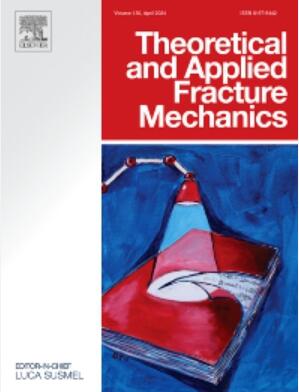Crack propagation behavior and failure prediction of rocks with non-parallel conjugate flaws: Insights from the perspective of acoustic emission and DIC
IF 5
2区 工程技术
Q1 ENGINEERING, MECHANICAL
引用次数: 0
Abstract
Rock-like containing non-parallel conjugate flaws specimens (NPCFS) were prepared and uniaxial compression crack propagation tests were conducted employing acoustic emission (AE) and digital image correlation (DIC) techniques. The results show that: the angle of conjugate unilateral cracks increases, the average load-bearing capacity of the rock rises. Dominant frequencies from different conjugate defect angles exhibit distinct bimodal characteristics (low-frequency: 80–140 kHz, intermediate-frequency: 260–320 kHz). The concept of AE dominant frequency ratio β is proposed and introduced to quantify the strength of macro-scale failure of the specimens. The AE multiparameter is proposed to predict the failure load, and the mean value of failure load is predicted to be in the range of 86–93 % (failure load), the prediction interval of Ib value is in the range of 95–99 %, the prediction interval of critical slowing down variance value is in the range of 90–95 %, while the prediction interval of autocorrelation coefficient is in the range of 83–90 %. A favorable correlation was observed between AE events in NPCFS and surface deformations observed through DIC technology. Both ends of the conjugate flaw cannot propagate simultaneously; once one extends, the other ceases further expansion, forming a primary failure line that propagates towards the direction of the primary compressive stress.
具有非平行共轭缺陷的岩石的裂缝扩展行为和破坏预测:从声发射和 DIC 的角度看问题
利用声发射(AE)和数字图像相关(DIC)技术制备了含有非平行共轭缺陷试样(NPCFS)的类岩石,并进行了单轴压缩裂纹扩展试验。结果表明:单侧共轭裂缝的角度增大,岩石的平均承载力也随之增大。不同共轭缺陷角度的主频表现出明显的双峰特征(低频:80-140 kHz,中频:260-320 kHz)。提出并引入了 AE 主导频率比 β 的概念,以量化试样宏观尺度破坏的强度。提出了预测破坏载荷的 AE 多参数,预测破坏载荷的平均值在 86-93 %(破坏载荷)之间,Ib 值的预测区间在 95-99 % 之间,临界减速方差值的预测区间在 90-95 % 之间,而自相关系数的预测区间在 83-90 % 之间。在 NPCFS 中观察到的 AE 事件与通过 DIC 技术观察到的表面变形之间存在良好的相关性。共轭缺陷的两端不能同时扩展;一旦其中一端扩展,另一端就会停止进一步扩展,形成一条向主压应力方向扩展的主破坏线。
本文章由计算机程序翻译,如有差异,请以英文原文为准。
求助全文
约1分钟内获得全文
求助全文
来源期刊

Theoretical and Applied Fracture Mechanics
工程技术-工程:机械
CiteScore
8.40
自引率
18.90%
发文量
435
审稿时长
37 days
期刊介绍:
Theoretical and Applied Fracture Mechanics'' aims & scopes have been re-designed to cover both the theoretical, applied, and numerical aspects associated with those cracking related phenomena taking place, at a micro-, meso-, and macroscopic level, in materials/components/structures of any kind.
The journal aims to cover the cracking/mechanical behaviour of materials/components/structures in those situations involving both time-independent and time-dependent system of external forces/moments (such as, for instance, quasi-static, impulsive, impact, blasting, creep, contact, and fatigue loading). Since, under the above circumstances, the mechanical behaviour of cracked materials/components/structures is also affected by the environmental conditions, the journal would consider also those theoretical/experimental research works investigating the effect of external variables such as, for instance, the effect of corrosive environments as well as of high/low-temperature.
 求助内容:
求助内容: 应助结果提醒方式:
应助结果提醒方式:


